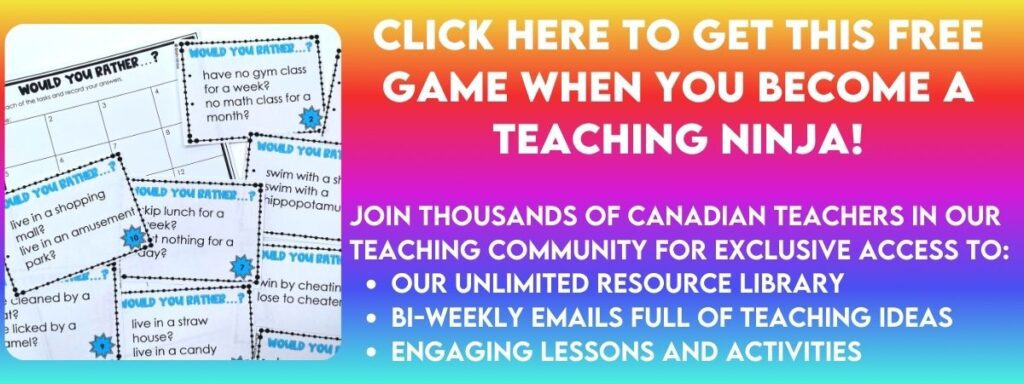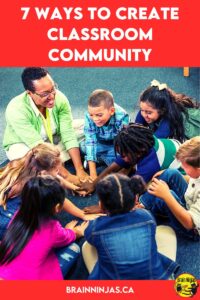
Have you ever seen those students that just work together in a classroom like a well-oiled machine? Have you ever dreamt of a classroom community full of harmony where students are on track and work together to learn in the best possible environment? It can happen, but building a caring classroom community doesn’t happen by chance.
We work hard teaching our students how to work together, how to care about each other and how to create a strong community of learners. Come read some of the ways we do this in our classroom.
Build Positive Relationships
Typically we teach a combined class, meaning we have students coming from different grade levels who don’t nessesarily know each other. Sometimes students already have preconcieved ideas about each other or they have already had experiences with others (both good and bad).
Regardless of how well your students already know each other, it is important to get to know them in the most positive way possible. For example, if a student has been labelled a troublemaker, it’s important to show everyone they have turned over a new leaf and this is a fresh start. If a student has had difficulties making friends previously, pair them up with a student who would be a good match.
Getting to know each other means students need lots of different ways to interact. They need to talk, create and learn from each other. They should play games and do a variety of activities that show off all their different abilities and characteristics.
We often think about friendships in the classroom that bring trouble together. Often, we actively work to handle these types of relationships proactively. However, we often forget that by building strong and positive relationships between students we can eliminate many of those problems easily.
A quick game you can play to get students talking is a Would You Rather? game. It is available in our Resource Library, or we can send a copy directly to your inbox when you sign up to be a teaching ninja.
Establish Routines
Students need routines. This doesn’t mean you need a big list of rules. Routines are structures or systems put in place to help maximize efficiency. The more students that know and follow the routines, the more people there are to help others who need help (instead of you helping).
Create Classroom Norms (Things Students Can Expect)
Just like a city, the classroom is a communities which needs general expectations for all its members. These need to be taught and then given time to practice. We use our Expected and Unexpected Behaviours Unit to go over a variety of situations so that the class can learn what is expected. It can be found in our TpT Store and our Brain Ninjas Shop.
Here is an example of one our classroom norms
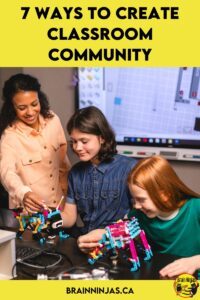
The pencil sharpener. It never fails that at soon as the class is quiet and ready to hear instructions or a lesson, someone needs to sharpen a pencil in the world’s nosiest pencil sharpener.
So, during one of the first days of school, we explain the common sense pencil sharpener question. Is it a good time to sharpen a pencil? Good times include when students are working, when the teacher or guest is not speaking to the class or when a pencil might be needed to continue.
If a student needs to sharpen a pencil during a lesson, they stand next to the sharpener and wait for the teacher to nod when there is a break in speaking. This is WAY better than having students sharpen while you’re speaking. And it doesn’t take them long to learn it.
The same goes for students learning to clean up after themselves. Show them where they can find a little broom and dustpan if they make a mess on the floor. Or show them where they can find a cloth to wipe up a mess. Include where to store these items and what to do if the mess is bigger.
Give students routines and they’ll start to manage themselves. You can read more about how we do this in our post How to Create a Sense of Agency in the Classroom.
Try House Teams
Divide your class evenly into four or five teams. The arrangement can be your choice, but we always tried to mix up the teams in such a way that there were equal opportunities for academic, social emotional and athletic endenvours.
Each team gets a coffee can or some other container they can decorate. It needs to have a lid that can be taken off and on like coffee can. You’ll be using bingo chips (or poker chips) as the currency, so they need to be able to fit through the lid.
Have teams come up with a name for their team, a motto, a secret handshake and maybe even a chant. Let them be creative.
As they are working, let them know they’ll work as a team to do exceptional things. That means there are no rewards for doing the things you’ll expect of the whole class. Instead, you’ll be looking for the students and team members who go above and beyond.
Each time you catch students going the extra mile, reward them with a chip that goes in their can. We reward students who do extra without with being asked and helping others in our classroom and in the school community. We look for students who do special things without expecting anything in return. Don’t forget to catch the kids who are trying their best (even if their best is not someone else’s).
Work Together on Collaborative Tasks

While not everything you do in school (and in the world) needs to be done together, everyone needs to learn how to live with a variety of people who may or may not agree. Teaching students to work together on a common goal, helps most students learn to work as part of a team. Some students are so competitive that their desire to win outweighs any good that working together does.
So, collaborative tasks shouldn’t be competitive. They should need everyone’s work to be complete. When you assign them, set students up for success by giving them a portion they can complete successfully. We have an entire post full of ideas: How to Use Collaborative Tasks to Create Classroom Community.
One simple task is this Welcome Poster. It can be found in our Resource Library (and yes, there is a French version available). If you’re not yet a ninja, we can send a copy directly to your inbox when you join our email list.
Hold Class Meetings (For Big Kids)
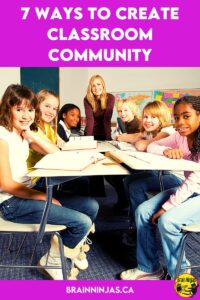
If you’re already rolling your eyes, just take a moment to hear us out. We’ve been there. When we were told we were going to be required to hold class meetings as part of our overall school behaviour plans, it seemed like a big waste of time.
We might have jumped to conclusions a little early. First, your students will be able to read your attitude so if you think it’s a waste of time, they will too. Second, they don’t need to take more than a few minutes. Third, some of your students might actually benefit so it’s worth a try.
Have students sit in a circle. We typically push our desks to the side and sit in chairs.
Choose an object that will be passed around the circle. The person holding the object is the only one speaking.
Explain that students have the right to pass (meaning they don’t have to answer), but you’ll come back around to them to give them another chance. Sometimes students need a little more time to process their answer. Sometimes they are too shy to share. Be patient.
Explain that part of being respectful in the circle is listening and giving the speaker your attention. Remind them that we don’t judge each other or use comments to hurt each other. We try not to interrupt and comment on other students’ answers. If we have a comment, we wait until it’s our turn or we signal that we would like the talking object next.
Start with simple questions and simple answers. For example, ask students if they prefer to do silent reading in the morning or in the afternoon. The answers really don’t matter. Practice having the meetings with these simple questions until it is routine and your students know how to act.
As your students get to know each other, they will become more comfortable. You’ll be able to use the meeting to discuss problems your students are having, do your health class discussions, or if your class suffers loss, you will have a routine to help work through the process.
Enjoy Some Class Games
We like to play team-building games to have some fun and help build relationships in creative and low-risk ways. Some of our favourite activities are found in our Classroom Community Unit. It is available in our TpT Store and our Brain Ninjas Shop. The games encourage teamwork, communication and collaboration.
We add games to our gym class. We have a whole post about different games for the playground: Why You Should Revive Old Playground Games. There is also a post about games to use in gym class: Energize Your Gym Class With Very Little Equipment.
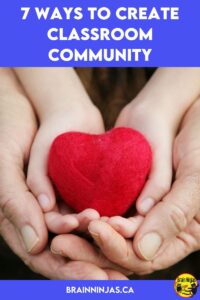
Teach Students to Work in Groups
One of the best ways to encourage community is to explicitly teach students how to work together in group situations. We have an entire blog post about working groups because there are so many different ways to help teach students about cooperation: How to Teach Students to Work in Groups.
In a group setting, students need to understand their own group role, how groups make decisions and how to resolve disputes. We use activities from our Group Roles and Processes Unit. It is available in our TpT Store and Brain Ninjas Shop.
Looking for Other Ways to Build Classroom Community?
You might find these blog posts helpful.
How to Make Students Listen Without Yelling
How to Build Relationships With Students
3 Ways to Support Introverts in Your Classroom
How to Save Your Sanity in the Classroom
How to Create a Community Culture in Your Multi-Grade Classroom
What other ways do you build classroom community in your upper elementary classroom? Tell us about it in the comments below.

